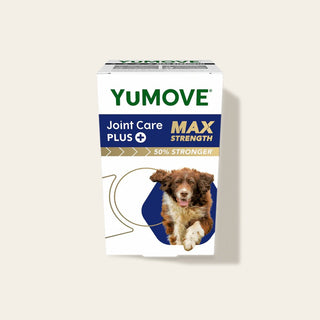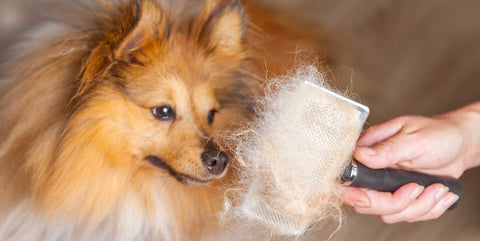

What Are Harvest Mites on Dogs?
From late July into November, these pesky pests can make our canine and feline friends feel far from 100%. So, what’s happening when harvest mites appear, how can you help to prevent the problem and soothe the scratching if the worst happens? Here’s the YuMOVE lowdown on how to avoid, spot and treat harvest mites on dogs, and help your pet feel more comfortable.
Harvest mites (Trombicula autumnalis) can cause seasonal skin challenges for dogs during late summer and autumn. The first active stage in the life cycle of the harvest mite is the six-legged larva – and this is the tiny pest that causes big problems for our pets.
Harvest mite larvae are active during the day, especially when it’s dry and sunny. They congregate in large groups on small clods of earth, long grass, matted vegetation, and even on low bushes and plants. When harvest mites come into contact with any warm-blooded animal, they’ll swarm on and often congregate around your dog’s front legs (on their chest, between their toes and in their ‘armpits’), on tummies and necks and around the genitals.
Why do harvest mites cause itching?
Unlike fleas and other parasites, harvest mite larvae don’t burrow into the skin or suck blood. Instead, they feed by thrusting small hooked fangs into the skin surface. Once attached, they inject powerful digestive enzymes which break down the skin cells. Once the cells disintegrate, the larva sucks up its liquid lunch. The mite will inject and suck at the same site for 2-3 days, until it is full – and has grown 3-4 times in size.
Symptoms of harvest mites on dogs
You may notice your dog scratching within 3 to 6 hours of exposure to harvest mites – but the unfortunate news is that the itch can continue for several weeks afterwards.
Harvest mites can cause rubbing, biting, and scratching, as well as scurf and hair loss in some dogs. If the skin is damaged due to lots of scratching and nibbling, affected areas can also become infected with bacteria.
The itching is usually caused by your dog’s reaction to the harvest mite’s digestive enzymes, and irritation levels vary from dog to dog.
What do harvest mites look like?

Keep your eyes peeled for tiny reddish or orange larvae. These nasty little biters are around 0.2mm long and can be found all over the UK.
Heavy infestations may be sharply localised – even to the extent of being abundant in one garden and absent from others in the same area. They’re equally at home in the countryside, in town gardens and parks. In fact, there are local variations of the Trombiculidae family all over the world.
How to spot an infestation of harvest mites
It’s not easy to spot a harvest mite infestation, because they’re so small. If your dog is scratching, spread the hairs and look carefully at the skin, especially between their toes or any area they seem irritated by. If there’s reddish or orange-coloured ‘dust’ attached to the hairs or the skin, your pet might have harvest mites.
Preventing harvest mites
Because harvest mite larvae are most active during the day, you can reduce the risk of harvest mites by modifying your pet’s routine. Consider going for walks early in the morning or after dusk. If possible, avoid long grasses and vegetation, and keep moving – the worst infestations tend to happen when pets (and people) are sitting or lying down in a sunny spot in the middle of the day!
It is also a good idea to check your dog’s paws and fur regularly. This will help you hopefully notice any harvest mites quickly, along with helping you identify any other possible concerns, such as grass seeds stuck in their fur.
Harvest mite treatment for dogs
Unfortunately, there’s no licensed treatment for harvest mites available in the UK. However, some flea treatments are said to be effective – it’s best to get advice on which is most suitable for your dog from your vet. If left untreated, the larvae will feed for a few days and then drop off. Unfortunately, though, the itchy symptoms can last for several weeks or even months, so the sooner you start helping your pet cope with the issue, the better.
Safe ways to relieve the itch

At YuMOVE HQ, we understand just how itchy and infuriating harvest mites can be for dogs. Fortunately, your vet will be able to help, and we also have a couple of products that can help offer relief.
Itch relief for dogs
By adding a skin-supporting supplement to your dog's food, try YuMOVE Skin and Coat Care Itching Dog to soothe itchy skin and help your pet feel their best!
How does YuMOVE Skin and Coat Care Itching Dog help soothe itchy pets?
The clever combination of Omega-3 and Omega-6 fatty acids help to calm the skin, relieving itching and scratching. The Omega-6s in the supplement also help to nourish and maintain the skin’s barrier. Better yet, YuMOVE Skin and Coat Care Itching Dog includes lots of natural Vitamin E to support the skin’s natural defences.
For more support for your dog’s skin and coat take a look at our Dog Skin and Coat Care supplements.



